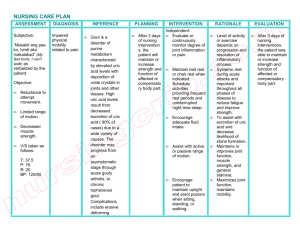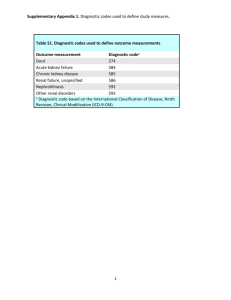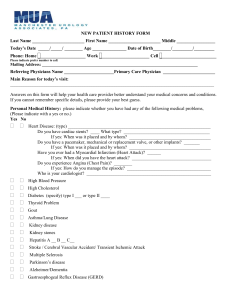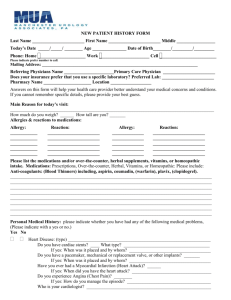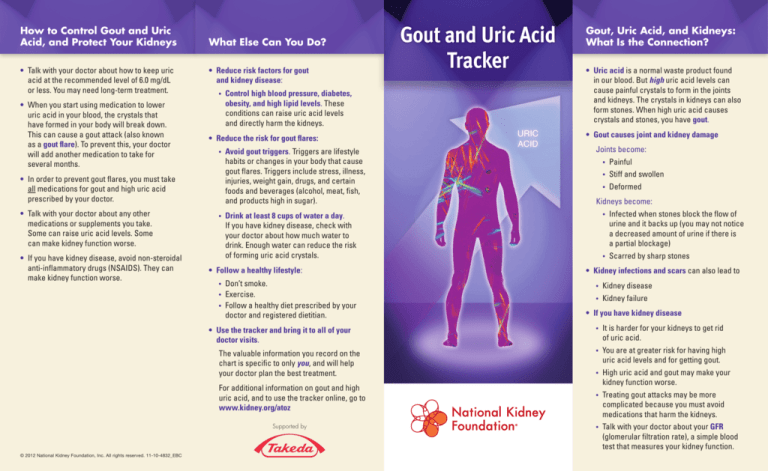
How to Control Gout and Uric
Acid, and Protect Your Kidneys
• Talk with your doctor about how to keep uric
acid at the recommended level of 6.0 mg/dL
or less. You may need long-term treatment.
• When you start using medication to lower
uric acid in your blood, the crystals that
have formed in your body will break down.
This can cause a gout attack (also known
as a gout flare). To prevent this, your doctor
will add another medication to take for
several months.
What Else Can You Do?
• Reduce risk factors for gout and kidney disease:
obesity, and high lipid levels. These
conditions can raise uric acid levels
and directly harm the kidneys.
• Reduce the risk for gout flares:
• In order to prevent gout flares, you must take
all medications for gout and high uric acid
prescribed by your doctor.
• Talk with your doctor about any other
medications or supplements you take.
Some can raise uric acid levels. Some
can make kidney function worse.
• If you have kidney disease, avoid non-steroidal
anti-inflammatory drugs (NSAIDS). They can
make kidney function worse.
• Control high blood pressure, diabetes,
• void gout triggers. Triggers are lifestyle
A
habits or changes in your body that cause
gout flares. Triggers include stress, illness,
injuries, weight gain, drugs, and certain
foods and beverages (alcohol, meat, fish,
and products high in sugar).
• Drink at least 8 cups of water a day.
If you have kidney disease, check with
your doctor about how much water to
drink. Enough water can reduce the risk
of forming uric acid crystals.
• Follow a healthy lifestyle:
• Don’t smoke.
• Exercise.
• Follow a healthy diet prescribed by your
doctor and registered dietitian.
Gout and Uric Acid
Tracker
Gout, Uric Acid, and Kidneys:
What Is the Connection?
• Uric acid is a normal waste product found
in our blood. But high uric acid levels can
cause painful crystals to form in the joints
and kidneys. The crystals in kidneys can also
form stones. When high uric acid causes
crystals and stones, you have gout.
• Gout causes joint and kidney damage
• Painful
• Stiff and swollen
• Deformed
• Scarred by sharp stones
• Kidney infections and scars can also lead to
• Kidney disease
• Kidney failure
• If you have kidney disease
The valuable information you record on the
chart is specific to only you, and will help
your doctor plan the best treatment.
Supported by
Kidneys become:
• Infected when stones block the flow of
urine and it backs up (you may not notice
a decreased amount of urine if there is
a partial blockage)
• Use the tracker and bring it to all of your
doctor visits.
For additional information on gout and high
uric acid, and to use the tracker online, go to
www.kidney.org/atoz
Joints become:
• It is harder for your kidneys to get rid
of uric acid.
• You are at greater risk for having high
uric acid levels and for getting gout.
• High uric acid and gout may make your
kidney function worse.
• Treating gout attacks may be more
complicated because you must avoid
medications that harm the kidneys.
• Talk with your doctor about your GFR
(glomerular filtration rate), a simple blood
test that measures your kidney function.
© 2012 National Kidney Foundation, Inc. All rights reserved. 11-10-4832_EBC
GOUT AND URIC ACID TRACKER
DATE OF EXAM
/
/
/
/
/
/
/
/
/
/
/
/
/
/
/
/
sUA (Serum uric acid: uric
acid level in the blood)
GFR (Glomerular filtration
rate: blood test for kidney
function)
Urine Albumin-Creatinine Ratio (Urine test for signs
of kidney damage)
Blood Pressure
Weight
DATE OF FLARE
Where is the pain?
Level of pain (Circle your level of pain)
No Pain
Worst Pain Possible
Triggers
Medications and dosages to treat gout
For additional information on gout and high uric acid, and to use the tracker online, go to www.kidney.org/atoz


